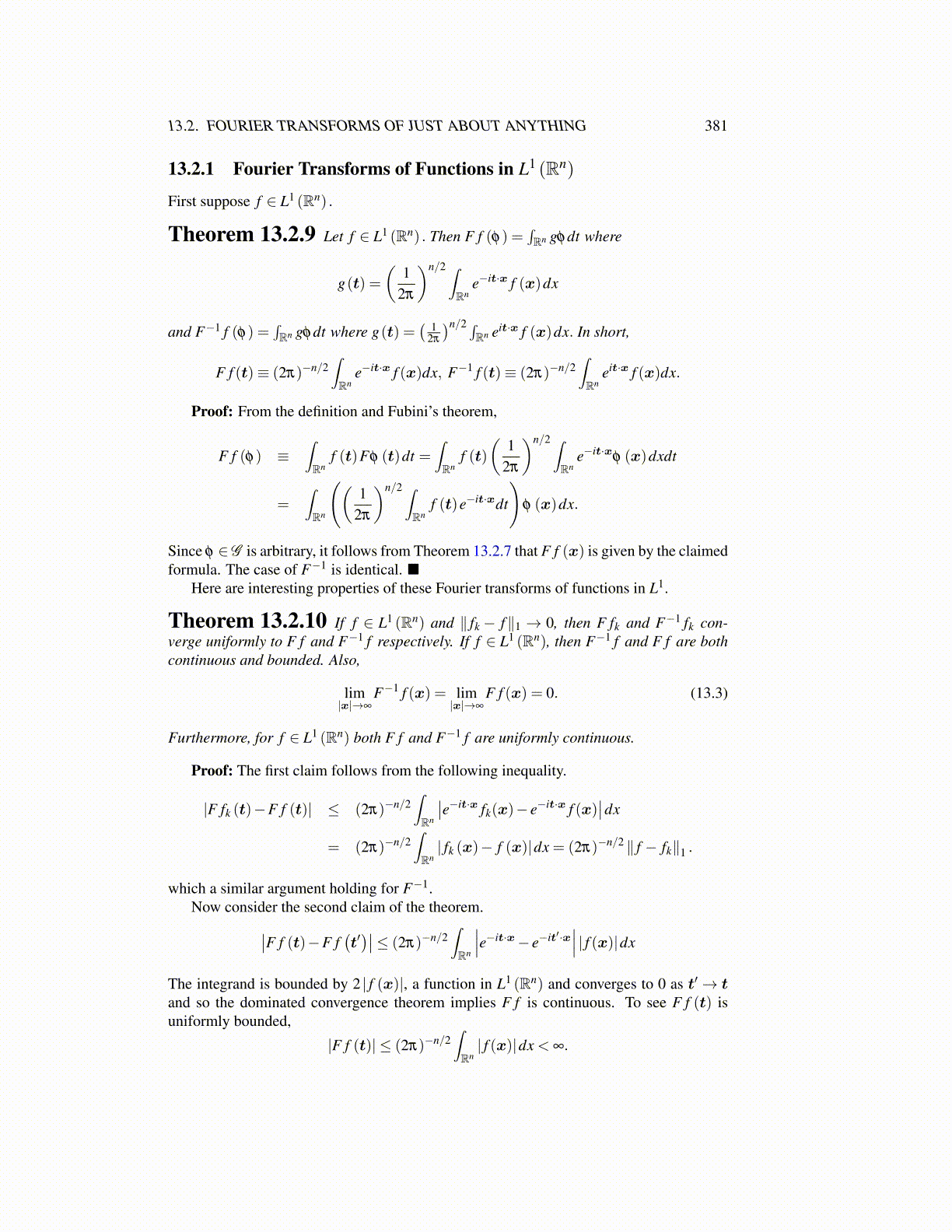
13.2. FOURIER TRANSFORMS OF JUST ABOUT ANYTHING 381
13.2.1 Fourier Transforms of Functions in L1 (Rn)
First suppose f ∈ L1 (Rn) .
Theorem 13.2.9 Let f ∈ L1 (Rn) . Then F f (φ) =∫Rn gφdt where
g(t) =(
12π
)n/2 ∫Rn
e−it·x f (x)dx
and F−1 f (φ) =∫Rn gφdt where g(t) =
( 12π
)n/2 ∫Rn eit·x f (x)dx. In short,
F f (t)≡ (2π)−n/2∫Rn
e−it·x f (x)dx, F−1 f (t)≡ (2π)−n/2∫Rn
eit·x f (x)dx.
Proof: From the definition and Fubini’s theorem,
F f (φ) ≡∫Rn
f (t)Fφ (t)dt =∫Rn
f (t)(
12π
)n/2 ∫Rn
e−it·xφ (x)dxdt
=∫Rn
((1
2π
)n/2 ∫Rn
f (t)e−it·xdt
)φ (x)dx.
Since φ ∈G is arbitrary, it follows from Theorem 13.2.7 that F f (x) is given by the claimedformula. The case of F−1 is identical. ■
Here are interesting properties of these Fourier transforms of functions in L1.
Theorem 13.2.10 If f ∈ L1 (Rn) and ∥ fk − f∥1 → 0, then F fk and F−1 fk con-verge uniformly to F f and F−1 f respectively. If f ∈ L1 (Rn), then F−1 f and F f are bothcontinuous and bounded. Also,
lim|x|→∞
F−1 f (x) = lim|x|→∞
F f (x) = 0. (13.3)
Furthermore, for f ∈ L1 (Rn) both F f and F−1 f are uniformly continuous.
Proof: The first claim follows from the following inequality.
|F fk (t)−F f (t)| ≤ (2π)−n/2∫Rn
∣∣e−it·x fk(x)− e−it·x f (x)∣∣dx
= (2π)−n/2∫Rn| fk (x)− f (x)|dx = (2π)−n/2 ∥ f − fk∥1 .
which a similar argument holding for F−1.Now consider the second claim of the theorem.∣∣F f (t)−F f
(t′)∣∣≤ (2π)−n/2
∫Rn
∣∣∣e−it·x− e−it′·x∣∣∣ | f (x)|dx
The integrand is bounded by 2 | f (x)|, a function in L1 (Rn) and converges to 0 as t′→ tand so the dominated convergence theorem implies F f is continuous. To see F f (t) isuniformly bounded,
|F f (t)| ≤ (2π)−n/2∫Rn| f (x)|dx < ∞.